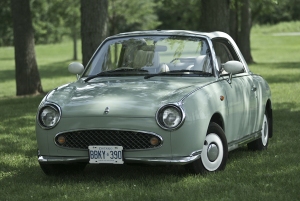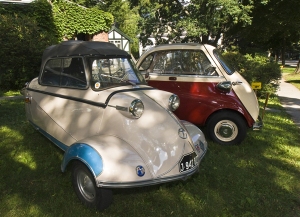Electrifying the Road
It’s not that I am a firm believer or a devout champion of the cause..I still need to be convinced…but I find the history and the growing future of electric vehicles fascinating. I posted previously about the Canadian built Zenn and electric car proponent Shia Agassi, but there is interesting developments right here in my own backyard (Ottawa Ontario). I have worked with the folks of the Electric Vehicle Council of Ottawa (EVCO) for the past couple of years with our National Capital Electrathon electric car race. (Pictures soon at photowagon.ca). This is an annual event (except for last year) where high school students design and build an electrically powered non-recharged car in a race for the number of laps in a given time period (one hour). (You run a single 12V car battery until it dies…it is a design exercise of engineering efficiency).
Anyway, the EVCO folks were featured on a CBC (Canadian Broadcasting Corp) news item. The EVCO guys and gals take beat up cars, strip out the gasoline engines and replace it with an electric motor. A true hacking experience, you have to admire these back garage pioneering entrepreneurs. Perhaps these Mad Max creations won’t go very far on a charge, and won’t be featured on a NASCAR track any day soon, but you gotta admire the perseverance and the ideology. Their creations might not be the direct answer to the problem of transportation in the world wide future, but then again, one never knows where the next Henry Ford will come from.
Check out the EVCO folks at evco.ca/, and see about the CBC coverage at evco.ca/site/CBC-24jun2008
Shai Agassi…meet Zenn
I read with great interest the cover article “Driven” by Daniel Roth in Wired Magazine (16.09 Sept. 08, page 118). The cover says: The Future of the Electric Car” and that seems just about right. In the worldwide future, design is more than just coming up with a product or service. Design must consider the entire scope, enterprise and life cycle of a designed solution. A designer of a product or service must consider the entire enterprise, or how it connects with the entire infrastructure of society. Consider how the world has changed since Edison invented the light bulb: even improving on the original design (for example: compact fluorescents) brings about a whole new set of problems (questions about the actual lifespan, the use of dangerous chemicals, disposal, environmental costs of manufacturing vs. incandescence, the list goes on. (My quote from teaching design: Design is what you do when you don’t know the answer…or the question).
The electric car is a case in point. Zero emissions are a noble goal, but how much will that car cost the consumer, or the environment? What chemicals will have to dealt with in manufacture; or in disposal? What do you do when your battery quits taking a charge? How much will a replacement cost? How much will it cost to build the infrastructure to support electric cars? I really would like to know the answers to these questions, especially from GM, who has been advertising its ephemeral Chevrolet Volt for some time already as if it already exists.
Shai Agassi, a young entrepreneur, has come up with an idea for building a sustainable (key word!) business (Better Place): an electric network that will support a new age of smart electric cars. Agassi’s idea is that you essentially lease the car and battery, and pay for its use through metered electricity. (Like the free cell phone paid for by usage or, going way back to that prime example of Chris Anderson’s Zero Economy, the King Gillette’s disposable shaving blade). The benefits are that you don’t have to buy an expensive car or more importantly, an expensive battery that will need replacing after so many charges. The car is provided to you, you pay for it by paying for the consumable portion: the electricity. The company develops the charging stations and the retailing infrastructure. If you need a fresh battery for a long trip, you just go to the charging station where they swap in a new battery in 10 minutes. You don’t need to worry about the cost of ownership and replacing worn out batteries. You pay for what you use, which is the way everything should be.
The idea is there, and Roth’s story outlines the process Agassi has been going through in finding a place to do trials, and a manufacturer to produce the vehicles and stations. A single car has yet to be produced. Brought to my mind our own (Canada) home grown electric car that is sold through out the world by the Toronto based Zenn Electric Company. Seems to me Agassi, you have a solution…Zenn already has the cars, and better yet the world wide license to develop electric vehicles using EEStor’s innovative high capacity battery system (three times the storage capacity of lithium ion). And, Transport Canada has finally allowed (just barely…they do need a kick in the ass) the use of these cars here in Canada.
Agassi…meet Zenn. Is this the solution we have been waiting for?
Zenn and the art of motor vehicle ownership
I just returned from the 13th annual Gould’s Micro Car Classic in Newton Mass., and it was a blast. We drove our 1991 Nissan Figaro down from Ottawa Ontario, about a 7-1/2 drive. My Figaro is not quite a microcar, but it is a minicar, powered by a one litre turbo. The Nissan Figaro was a one-off creation by the Pike Factory, a design division of Nissan, who created four different retro styled vehicles based on the dimunitive Micra platform. I always wanted something unique to drive, and this JDM (Japanese Domestic Market) car is about unique in these here parts as you can get. The looks on people are wonderful to behold, and I have met many people who just have to come by and ask “what is that?!”
Now even though the Figaro is unique, the MicroCar classic is quite a collection of unique vehicles. One has to be amazed at the engineering represented by these vintage cars, typically made from the 1930s up to present day (in the form of the Smart car or Mini-Cooper, though the majority was made from 1930s to 1960s). From Messerschmitts to Bantams to Goggomobiles to Isettas, these cars represent a time where affordability and gas mileage were the critical criteria. Sounds an awful like what we need to consider today. While you can’t say that some of these machines are easy on the environment, I think they do represent the world wide future. Consider…what do we really need to move about town, two tons of steel and a massive V8 engine or a small footprint automobile that gets 50mpg (2l/100km)?
There are many things to consider safety wise but I have a feeling that current regulations represent a massive hurdle to fostering innovation and allow for cheaper and greener alternatives. Consider that here in Canada we have the innovative Zenn Corporation (among others), building all electric vehicles for low speed inner city transportation. However, Transport Canada regulations prevent these from being sold in Canada! They are sold all over the world except for here in our own country. It is time to change regulations and breed innovation, because these times call for new ideas and radical departures from the way things were. The amount of testing that is currently required stops all but big money from getting into the market. Importation rules like an age limit (15 years or older in Canada, 25 years or older in the US for example) needs to change to allow importation of specialty cars (read green cars) for individual use.
I think that the Brand Credo from Zenn says it all:
Since we first began to walk, we have loved the feeling of movement.
To get around and see the world.
To be free.
Cars have given us mobility.
But with the heavy costs of pollution and oil dependency.
ZENN is about returning to the purity of that original feeling.
ZENN may look like a car, but it refuses to act like one.
You’ll experience the simple joy of moving freely.
With silent, exhilarating acceleration
ZENN will quietly change the way you think about getting from A to B.
The air is clean and your conscience is clear.
ZENN is a car that, while it runs on electricity, is fueled by optimism,
The belief that individuals can make a difference,
That we can do better.
ZENN is enlightened mobility
A call to arms perhaps, time for the people to demand that innovation be rewarded, that special rules make it allowable to try greener alternatives. On the education front, it would be ideal if more corporation and government help be offered to high schools and post secondary institutions to help boost engineering projects related to futurethink transportation. There are a number of interesting projects such as solar or electric car races that will no doubt bring some answers to the question of how we will move around in the future.
I have seen the future, and it is smaller.
-M.Scott 2008
-
Archives
- June 2010 (2)
- October 2009 (1)
- July 2009 (1)
- May 2009 (1)
- January 2009 (2)
- December 2008 (3)
- November 2008 (3)
- October 2008 (1)
- September 2008 (2)
- August 2008 (3)
- July 2008 (6)
- June 2008 (2)
-
Categories
-
RSS
Entries RSS
Comments RSS



